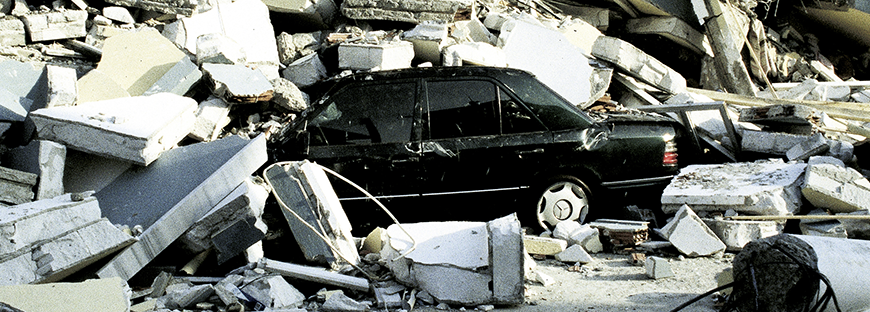07.07.2016: The Centre for Early Warning Systems (EWS) at the GFZ deals with the design and implementation of early warning systems for different natural disasters. The scientists also assess the risks arising from earthquakes as well as from other related geo-hazards. The research results can be used by civil protection authorities and decision-makers for disaster risk reduction and prevention measures. On both topics the EWS presents new studies.
The challenge of global risk modeling
Natural disasters can have different causes like earthquakes or tsunami. However, they tend to damage the same assets, mostly people, buildings, and infrastructure. Scientists describe this as the “exposure”. Within a new study the EWS scientists Dr. Massimiliano Pittore, Dr. Marc Wieland (currently at Oxford University, Great Britain) and Dr. Kevin Fleming assess the challenge of implementing an exposure model at a global scale.
The assessment of exposure is a dynamic process, varying in time and space depending on several factors. There is for instance the global tendency of “rural exodus”, the migration from rural to urban areas. It results in the ever increasing concentration of infrastructure and buildings. In case of a catastrophic event the expected impact would therefore be much higher in an urban are than in a rural area. Therewith the exposure is higher in a city than in a rural area.
Within their study the EWS scientists show that the exposure for a global risk modeling has to be ideally estimated in a continuous process. Therefore data need to be cyclically collected – e.g. by the means of remote sensing -, validated, and made readily available. A major challenge is to deal with the dynamics of risk. The study is a first step in developing dynamic global exposure models.
Improving earthquake early warning
The EWS not only deals with the risks that comes with a hazard but also investigates how an early warning for these hazards can be improved. Within a new study, Marco Pilz from the Swiss Seismological Service at the ETH Zurich, Switzerland, together with Prof. Stefano Parolai, Head of the EWS, propose a method that allows for a site-specific forecasting of earthquake ground motion in real time.
Ground motions induced by an Earthquake and their duration at one specific site may differ significantly from other sites. This is due to the fact that waves generated by an earthquake are influenced by the structure of the shallow underground: Seismic waves propagate differently through soft soil layers near the surface than through hard rock. This phenomenon is known as “site amplification”, which can vary over short distances. It significantly influences the damage to structures.
The scientists describe a method where the forecasting of strong ground motion immediately following an earthquake is improved. When the seismic waves are recorded at a reference station on hard rock, according to the new approach it is possible to calculate in real time the shaking of the earthquake event at other sites over short distances. The only prerequisite is an assessment of the shallow geology of an area and to include its impact on the propagation of seismic waves. With this approach, the earthquake early warning and thus also the response to a disaster can be improved. (ak)
Pittore, M., Wieland, M., Fleming, K., 2016. Perspectives on global dynamic exposure modelling for geo-risk assessment. Natural Hazards. DOI: 10.1007/s11069-016-2437-3
Pilz, M., Parolai, S., Ground-Motion Forecasting Using a Reference Station and Complex Site-Response Functions Accounting for the Shallow Geology. Bulletin of the Seismological Society of America, 106 (4). DOI: 10.1785/0120150281








![[Translate to English:] Torsten Sachs in front of a climate station on a field](/fileadmin/_processed_/3/9/csm__TorstenSachs_bearbeitet_GS_4a1365ef84.jpeg)

![[Translate to English:] left image flood at the Ahrtal: image from above, several houses are flooded; left image:: Heidi Kreibich;](/fileadmin/_processed_/4/4/csm_Bild2_9af0130e9f.png)



![[Translate to English:] Start der Vega Rakete](/fileadmin/_processed_/6/4/csm_20231201-kachel_Vega-VV23-launch_ESA-CNES-Arianespace_706716b68c.jpeg)









![[Translate to English:] Poster exhibition at the Brandenburg Hydrogen Day at the GFZ, some participants in the foreground](/fileadmin/_processed_/6/5/csm_Erster_Brandenburgischer_Wasserstofftag_GFZ_402fcec95e.jpeg)
![[Translate to English:] Group picture of the participants](/fileadmin/_processed_/9/4/csm_20231108_CAWa-Workshop-Tashkent_Gruppenbild_99ea779d8a.jpeg)

![[Translate to English:] [Translate to English:] Hörsaal](/fileadmin/_processed_/e/6/csm_H%C3%B6rsal_e21ac645fb.jpeg)


![[Translate to English:] The Delegations in the Historic Library on the Telegrafenberg. In the back there are from left to right, the Dutch Ambassador for Germany, Ronald van Roeden, the Dutch Minister for Education, Culture and Science, Robbert Dijkgraaf and the scientific director of the GFZ, Susanne Buiter.](/fileadmin/_processed_/d/b/csm_Kachel-2_9eba4b4212.jpeg)

